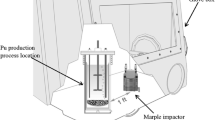Abstract
Prompt analysis of elemental and isotopic information from post-detonation nuclear debris is critical for rapid attribution analysis. In this work, the capabilities of dissolution methods that use ammonium bifluoride (ABF, NH4HF2) and pressurized microwave digestion with HF acid are reported for NIST Surrogate Post-detonation Urban Debris (SPUD). Elemental concentration and isotope ratios were measured using inductively coupled plasma mass spectrometry. The SPUD material was also analyzed for U concentration using instrumental neutron activation analysis. The ABF dissolution method with a 10:1 ABF to sample ratio and the pressurized microwave digestion methods resulted in comparable results.
Similar content being viewed by others
References
Moody KJ, Grant PM, Hutcheon ID (2015) Nuclear foresnsic analysis, 2nd edn. CRC Press, Boca Raton
Glastone S, Dolan P (1977) The effects of nuclear weapons. US Department of Defense and the Energy Research and Development Administration, Washington DC
Molgaard JJ, Auxier JD, Giminaro AV, Oldham CJ, Cook MT, Young SA, Hall HL (2015) Development of synthetic nuclear melt glass for forensic analysis. J Radioanal Nucl Chem. https://doi.org/10.1007/s10967-015-3941-8
Zhang W, Hu Z, Liu Y, Chen H, Gao S, Gaschnig RM (2012) Total rock dissolution using ammonium bifluoride (NH4HF 2) in screw-top Teflon vials: a new development in open-vessel digestion. Anal Chem 84(24):10686–10693
Hubley N, Brown JWN, Guthrie J, David Robertson J, Brockman JD (2016) Development of ammonium bifluoride fusion method for rapid dissolution of trinitite samples and analysis by ICP-MS. J Radioanal Nucl Chem 307(3):1777–1780. https://doi.org/10.1007/s10967-015-4371-3
Hubley N, Brockman JD, Robertson JD (2017) Evaluation of Ammonium Bifluoride fusion for rapid dissolution in post-detonation nuclear forensci analysis. Radiochim Acta. https://doi.org/10.1515/ract-2016-2735
Mason CA, Hubley NT, Robertson JD, Wegge DL, Brockman JD (2017) Sonication assisted dissolution of post-detonation nuclear debris using ammonium bifluoride. Radiochim Acta 105(12):1059–1070. https://doi.org/10.1515/ract-2017-2802
Makishima A, Tanaka R, Nakamura E (2009) precise elemental and isotopic analyses in silicate samples employing ICP-MS: application of hydrofluoric acid solution and analytical techniques. Anal Sci 25(10):1181–1187. https://doi.org/10.2116/analsci.25.1181
Wu S, Zhao YH, Feng X, Wittmeier A (1996) Application of inductively coupled plasma mass spectrometry for total metal determination in silicon-containing solid samples using the microwave-assisted nitric acid-hydrofluoric acid-hydrogen peroxide-boric acid digestion system. J Anal Atomic Spectrom 11(4):287–296. https://doi.org/10.1039/JA9961100287
Bock R (1979) A handbook of decomposition methods in analytical chemistry. Halted Press, New York
Mann JL, Tyra MA, Molloy JL, Paul R, Inn KGW, Buscaglia J, Leggitt J, Pfeuffer K, Fallon B, Dettman J, Haws D, Castro ST, Kelly TD, Turner D, McClory JW, Jerome S (2016) Surrogate post-detonation urban debris (SPUD): standard reference materials 4600 and 4601. In: Transactions of the American nuclear society, pp 405–407
Brockman JD, Brown JWN, Morrell JS, Robertson JD (2016) Measurement of uranium isotope ratios in keratinous materials: a noninvasive bioassay for special nuclear material. Anal Chem 88(17):8765–8771. https://doi.org/10.1021/acs.analchem.6b02144
Zhang W, Qi L, Hu Z, Zheng C, Liu Y, Chen H, Gao S, Hu S (2016) An investigation of digestion methods for trace elements in bauxite and their determination in ten bauxite reference materials using inductively coupled plasma-mass spectrometry. Geostand Geoanal Res 40(2):195–216. https://doi.org/10.1111/j.1751-908X.2015.00356.x
Acknowledgements
Funding for this work was provided by DTRA Grant No. HDTRA1-15-1-0016, and NRC fellowship award NRC-HQ-84-15-G-0036. Technical assistance at the University of Missouri from Jim Guthrie and Barry Higgins is greatly appreciated. The SPUD material was provided by Jackie Mann at NIST and was produced by the National Physical Laboratory, UK with funding from the FBI.
Author information
Authors and Affiliations
Corresponding author
Rights and permissions
About this article
Cite this article
Hubley, N.T., Wegge, D.L., Weilert, T.M. et al. Rapid dissolution of surrogate nuclear debris using ammonium bifluoride fusion and indirect sonication dissolution methods. J Radioanal Nucl Chem 318, 49–54 (2018). https://doi.org/10.1007/s10967-018-6127-3
Received:
Published:
Issue Date:
DOI: https://doi.org/10.1007/s10967-018-6127-3




